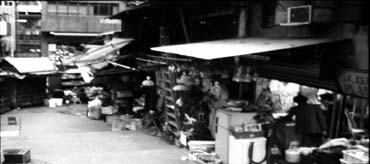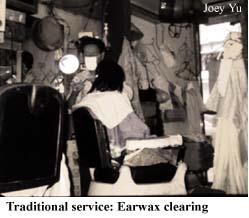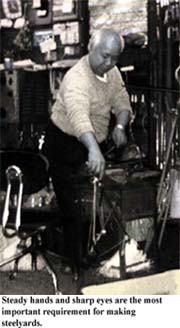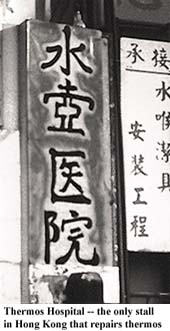 Several decades ago, traditional shops such as Shanghai barbers,
shops selling Chinese wedding gowns and shops repairing thermos were commonly found on street
corners.
Several decades ago, traditional shops such as Shanghai barbers,
shops selling Chinese wedding gowns and shops repairing thermos were commonly found on street
corners.
However, because of the rapid city development and the importation of new products, demands for these traditional products have been dropping in recent years. How do these craftsmen face the decline?
Mr. Ng Wah Sun opened his barber's shop in Mong Kok 37 years ago. Before, he was employed in a hair salon. The 82-year-old man's work site is the same as other hair salons, except the presence of an old style sliding gate, lights with flexible arm and the absence of a barber's pole.
There used to be five hairdressers in his stall but now only Mr. Ng, the oldest man among the hairdressers, is still able to work now.
"They have shaky hands, cataracts and weak legs so they cannot work any more," said Mr. Ng.
Differing from modern hairdressers, he does not spray or wash customers' hair before cutting.
"I can say this is redundant," he said.
Being a hairdresser, he also clears earwax for his customers. This traditional service is rare now.
 According to him, each clearance of earwax costs $20 when he
joined the field and now the charge is $80."
According to him, each clearance of earwax costs $20 when he
joined the field and now the charge is $80."
Some people regard clearing earwax as not hygienic and the tools used may accidentally damage the ear membrane. However, Ms Wong, a new customer of Mr. Ng's stall, is positive toward such service.
"I feel much more comfortable after my earwax is removed," she said.
She thinks that it is not painful when Mr. Ng cleans her ears.
Hairstyles change as time goes on. However, Mr. Ng's customers never ask him to keep abreast with the trend.
"We trust each other," said he.
Surroundings have changed with time, too.
Mr. Ng remembered that there used to be a residential area next to his stall.
Said he: "The doors were traditional sliding ones."
Today it has become a restaurant.
Mr. Ng admits that there are fewer customers nowadays because people like to keep long hair. Yet, he still has new customers and some of his regular customers bring their children to the stall for trimming.
On the other hand, other traditional businesses encounter a more doomed plight.
One example is the steelyard.
Mr. Hui Tsan Biu's steelyard stall is about 21 square feet. Supplies of steel are hanging in the stall. A small welding machine which is used to connect steel covers to the ends of the beams is placed near the door.
 Mr. Hui is proud of his tiny stall: "I am the only one who has this
welding machine now."
Mr. Hui is proud of his tiny stall: "I am the only one who has this
welding machine now."
The 63-year-old man followed his uncle to make such products when he was 18 years old.
The steelyard was the most popular scale in the past until the binary scale was introduced.
Mr. Hui has lost many customers in the past few years. The majority of his current customers are fishermen.
Said he: "On fish boats, a balance is useless since the boat is unstable which make the readings inaccurate."
According to Mr. Hui, sometimes a steelyard could be a tool to cheat customers.
"If you are an amateur, you will not understand the marks of the wooden beam," said he. Therefore, dishonest owners could cheat their customers by exaggerating the actual weight of the goods.
Mr. Hui closed his stall once but soon he reopened it in Sheung Wan This is because one of his customers invited him to take the job again as few people have the skills of making steelyards now.
According to him, a proper apprenticeship of steelyard making requires six years.
"The apprentice has to do the chores in the first three years and learns the skills in the next three years."
Mr. Hui emphasizes that steelyard making is not an easy task.
"Steady hands and sharp eyes are the most important requirements for making steelyards," he said.
According to him, the maker needs to drill holes in exact positions on the wooden beam and insert copper wire into them so that the end of the wire leaves a golden mark for measurement.
He thinks no one will inherit his skills of making steelyards as no new generation is engaged in the field.
"I belong to the younger generation in this field," said he.
Concerning the declining industry, he does not think that it is a pity because most people use balances now.
In recent years, the business has not been good though he can earn some money.
When he joined the field, he earned about $60 per month.
"At that time, the salary was quite acceptable."
Nevertheless, he thinks that the license fee and the rent are too expensive for him. On average, he needs to pay $3,000 per month.
Faced with such a situation, Mr. Hui does not switch to selling other goods.
"Many steelyard shops sell balances but I do not," said he: "I am old and cannot do too much."
Mr. Wong Kwok Che faces similar problems as Mr. Hui.
He inherited his family business more than 20 years ago.
Besides selling and repairing thermos, he also sells lunch boxes, moulds of traditional desserts and water bottles.
When he first inherited this business, he "neither liked nor disliked the job".
 However, after working in this field for many years, he changed
his attitude as it has brought him lots of memories.
However, after working in this field for many years, he changed
his attitude as it has brought him lots of memories.
Said he, "now I have strong feelings for my shop."
Beside his shop there is a big and old thermos that serves as a signboard and "Thermos Hospital" was painted on it.
He said, "It is more than 30 years old. It used to hold water for bathing when water was on short rations."
According to him, the 1970s was the prime time of the business and the decline began in 1980s.
The street was once full of thermos-repairing shops but Mr. Wong's shop is the only one left.
The main reason for the decline is that many factories have relocated to the mainland. As a result, there are fewer workers.
That students seldom bring lunch boxes to school is another reason.
Advanced technology and higher living standards have been major influences on Mr. Wong's business too.
"Plastic products, microwave food and fast food restaurants are popular now."
Thus, demand for traditional thermos has been falling. New thermoses have substituted for it.
He appreciates the design of new thermoses but he thinks that they are not very good at keeping water temperature high.
"The new ones are more beautiful and convenient to use.
"But they can only keep the temperature at around 90 to 100 degrees.
"The old ones could always keep the temperature at 100 degrees." He said.
Mr. Wong thinks that the repairing process is quite difficult and it needs skills and experience.
"It is difficult to place the vacuum flask in the outer coat without breaking the flask and the glass tube near the bottom of the flask."
He forecasts that his business would be terminated within three years.
The skills may be lost but Mr. Wong thinks this is the reality.